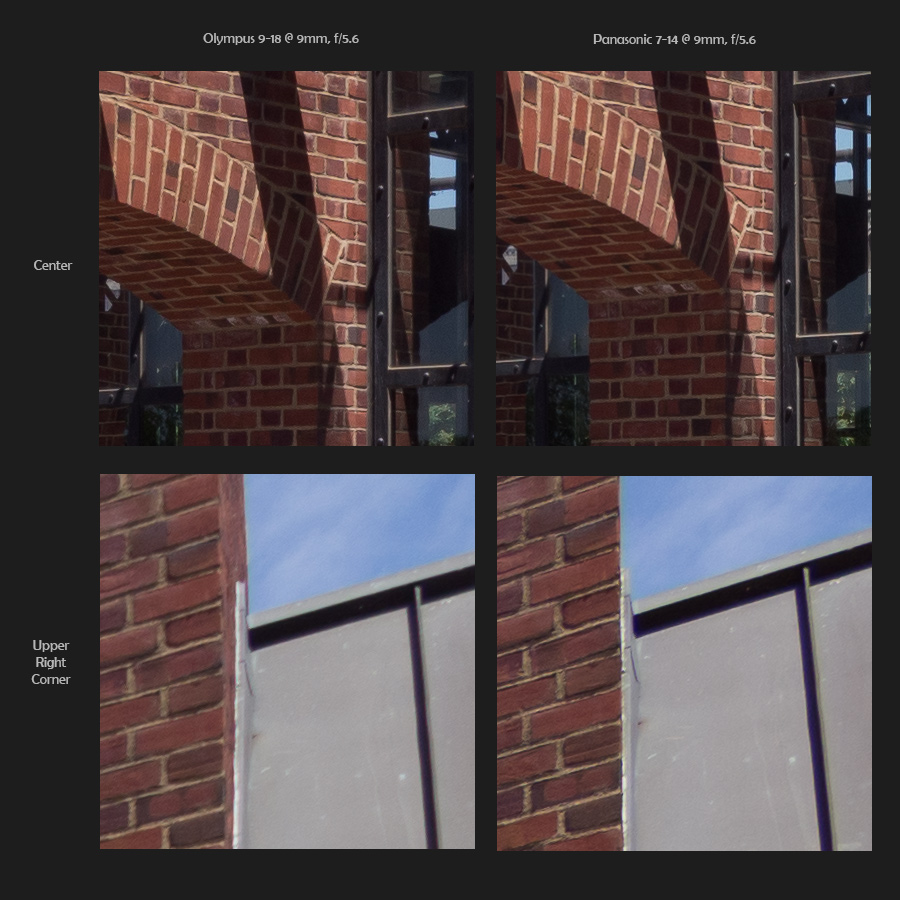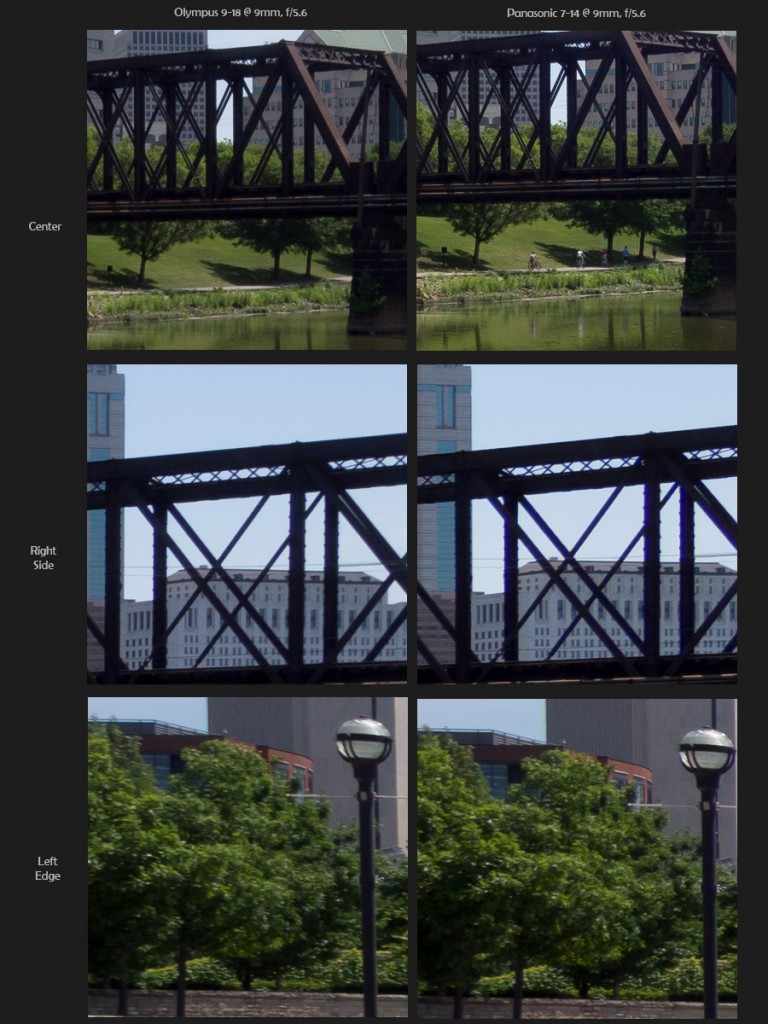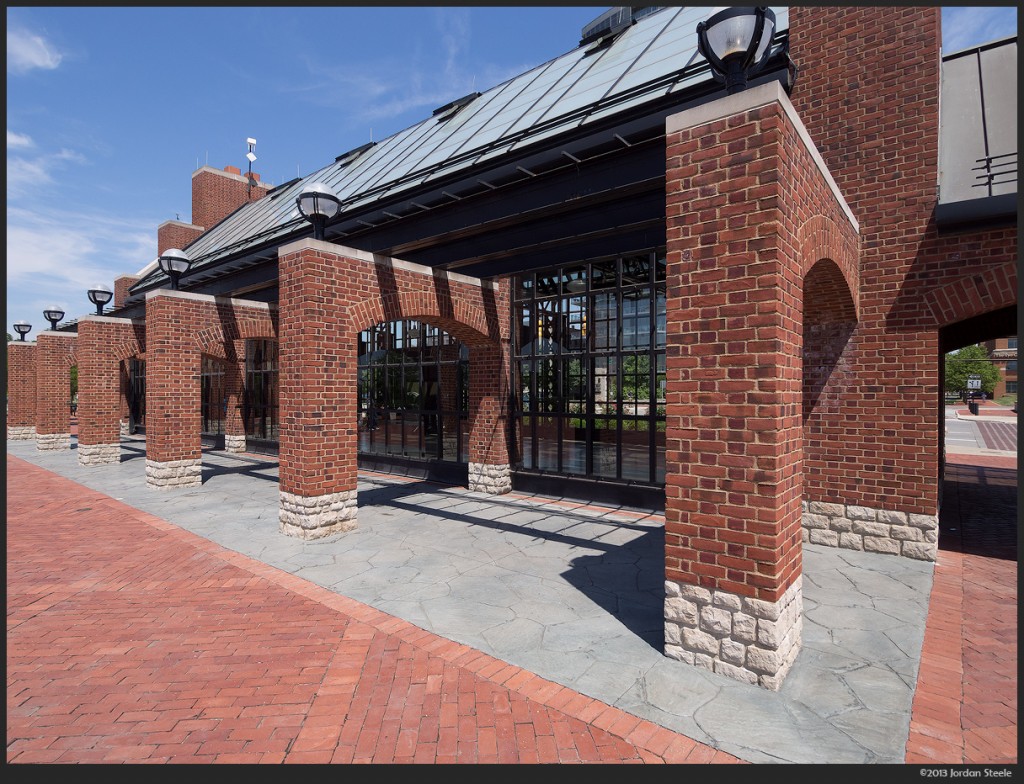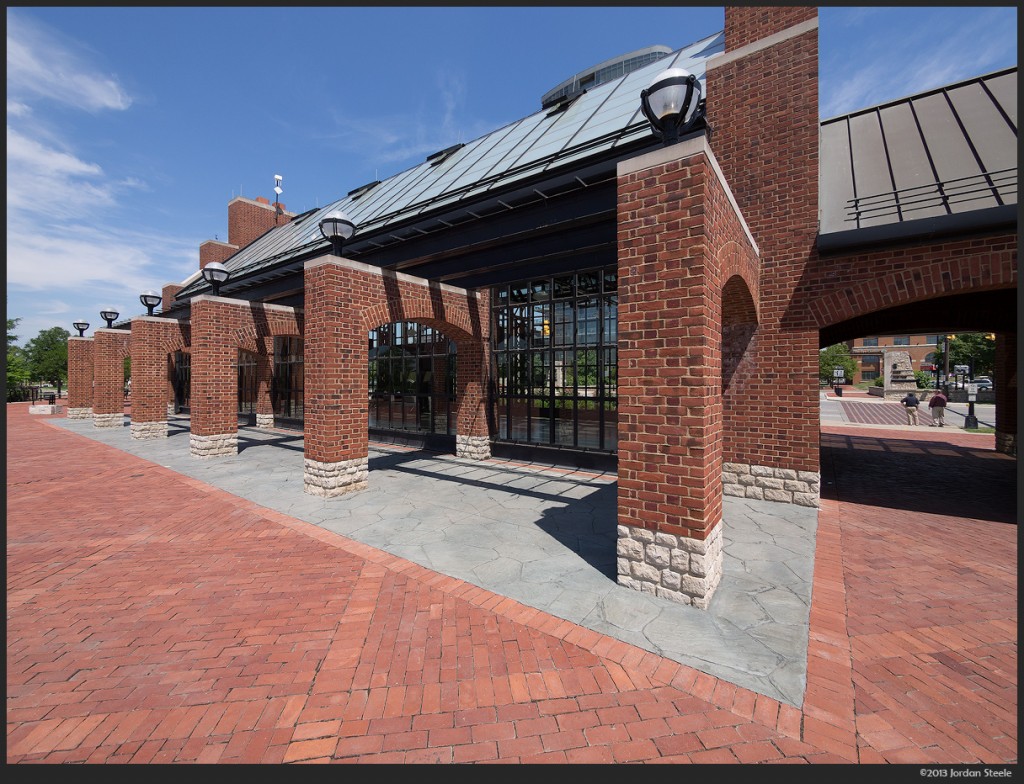Testing:

The following tests were performed in bright daylight using the OM-D E-M5 and each of the lenses. All comparisons below are at 9mm and f/5.6. For wide-angle use like this, shooting is generally done stopped down and both lenses perform best around f/5.6. I took shots of two scenes, one with a medium close subject, and one that would have the lenses focus closer to infinity. Both lenses were focused at the same focus point. With bright sunlight and the OM-D’s in-body IS, there should be no impact from camera shake. I performed Chromatic Aberration correction in Lightroom 5 for both lenses. As a note, the 9-18 has higher levels of lateral chromatic aberration right out of camera, though lateral CA is fully correctable on both lenses with Lightroom or other CA correction tools. Since it’s a normal part of my workflow, I decided to leave it here to get the best idea how the final image would look when shooting with these for real work.
Test 1:
The full scene for this first test is visible above (the Olympus shot is shown).
Below, you’ll see 100% crops from each of the lenses. The focus point was centered, and each lens was shot at the same settings. Crops were taken from the center of the image and the upper right corner for comparison. Click on the image (and click on the green arrow at the bottom of the screen after clicking if it is lit up) to view full size.

Here, the center crops show very little difference. Both are impressively sharp in the center region with good contrast and color. The Panasonic shows perhaps a hair more contrast. On the edge, the Panasonic performs a bit better, pulling higher levels of detail as well as a little higher contrast in the extreme corner. However, the Olympus still performs well here.
Test 2:
For the second test, I took a wide shot of the city along the river. Not my best work compositionally, but it provides detail at the edges on a predominantly infinity focused subject with some high contrast work thrown in. All shots again were taken at 9mm and f/5.6, focused in the center (the area where the pathway and the bridge cross). The full scene (the Panasonic shot is shown) is seen below:

Again, 100% crops are shown below. Here, there are crops from the image center, the right side near the edge, and the left edge. Again, click to enlarge, then click on the green arrow at the bottom of the screen to see the crops full size.

This test yields some interesting observations. First, the Panasonic is generally a little sharper across the whole frame at infinity, though the Olympus is very close in the center, but lags a little on the edges with regards to resolution. Still, both lenses again would yield fine prints here. The Panasonic does show one of its main weaknesses on the right side crop: Purple Fringing. While the lateral CA of both lenses is easily correctable with one click, purple fringing is harder to deal with. Lightroom has tools to reduce purple fringing, and they work in many instances, but in some cases, it can’t be properly corrected without serious work. There is obvious color fringing on the railroad bridge in the Panasonic shot.
Test 3 – Flare
Finally, since one of the other main complaints about the 7-14mm is its tendency to flare (especially with purple blobs in some cases on recent Olympus bodies), I took a shot with the sun in the top of the frame to take a look at how each lens responded with regards to flare. Click to enlarge each image.


Here, you can see that the Olympus 9-18 handles flare much better than the Panasonic. There is a slight hint of flare in the water below the one railroad trestle, and that’s about it. On the Panasonic side, there is much more complex flare, and the bright purple flare pops out as a few of the spots in the center. While in this image, the purple spots would be very easy to edit out, that is often not the case, so it is something to watch for.
Final Thoughts:
One final thing to note is the big strength of the Panasonic…width. Compare the 9mm shot that was used for the first test, to the extra width from the same spot with the Panasonic at 7mm:


The final rundown:
- The Panasonic 7-14mm is significantly wider than the Olympus 9-18mm
- The Panasonic 7-14mm is slightly sharper than the Olympus 9-18mm, especially on the image edges
- The Panasonic 7-14mm is more solidly built than the Olympus 9-18mm
- The Panasonic 7-14mm has better lateral CA control than the Olympus 9-18mm, though both are fully correctable in post-processing
- The Panasonic 7-14mm has a constant f/4 aperture through the zoom range, as opposed to the variable f/4-5.6 aperture of the Olympus 9-18mm
- The Olympus 9-18mm is significantly smaller than the Panasonic 7-14mm
- The Olympus 9-18mm controls purple fringing extremely well, unlike the Panasonic 7-14mm
- The Olympus 9-18mm controls flare much better than the Panasonic 7-14mm
- The Olympus 9-18mm can natively mount filters
- The Olympus 9-18mm is significantly less expensive than the Panasonic 7-14mm ($699 vs $959)
So at the end of the day: It’s really hard to choose between them. There are things each lens does very well, and some things that each lens doesn’t do so well. Ultimately, it’s going to come down to whether you feel the extra cost is worth it for the extra width of the Panasonic, or whether the size advantage of the 9-18 is more important. In my mind, they are close enough optically to make optical quality more or less a moot point between them. The Panasonic is sharper, but the Olympus controls other aberrations better, providing images without fringing or distracting flare. For me, I think the small size is going to end up winning out, and my much beloved 7-14mm will need to find a new home. I will miss that super wide end, however. I guess I’ll just need to bring my even wider Panasonic 8mm fisheye out more often.
Happy Shooting!





Leave a Reply